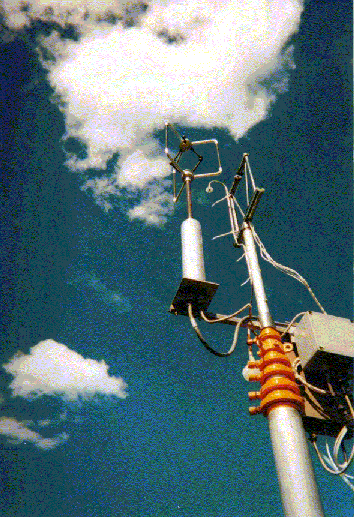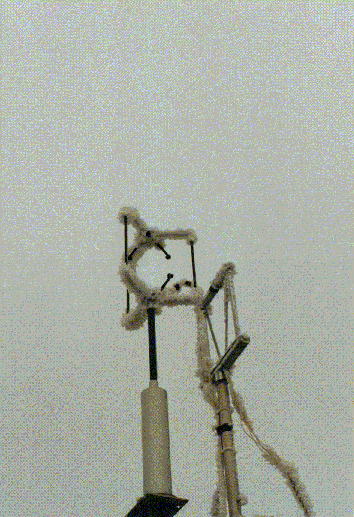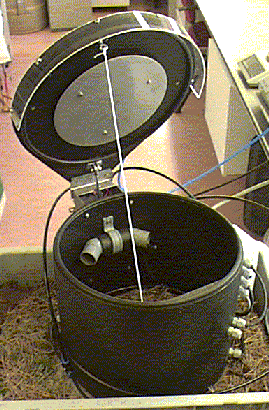

The carbon balance of a forest consists of the small net sum of two large quantities: assimilation by photosynthesis and respiration by plant and soil. This small balance determines whether the forests ecosystem absorbs or releases carbon (whether it is a sink or a source). To be able to separate these two components adequate measurements of both quantities are essential. Hence we propose to make optimum use of both partners' expertise by installing a comprehensive measurement setup above a larch forest at Yakutsk.
An eddy correlation instrument consisting of a 3-D Gill Solent sonic anemometer, a krypton hygrometer and a LICOR 6262 infrared gas analyzer was installed on an existing micrometeorological tower. This system measured the net ecosystem flux (NEE) and also latent heat (evaporation), sensible heat and momentum exchange. The system measures fast fluctuating components of vertical windspeed , humidity and CO2 concentration. The flux is determined from the correlation from the vertical windspeed, w' with the concentration fluctuations c'.
The covariances as well as the raw data are stored and post processed on site in Yakutsk by IBPC using Wageningen Environmental Research (Alterra) software which corrects for sensor misalignment, frequency loss, sensor separation etc. The data are available immediately.
 |
 |
Apart from the eddy correlation measurements, IBPC used a soil respiration chamber to measure soil respiration. The design of the chamber is based on existing prototypes in Europe and Russia. In particular the methodology used in the CarboEuroflux project was followed. The system consists of a control unit with soil respiration chambers and supplementary measurements of soil moisture, soil temperature and rainfall. Power is supplied by a 12V battery charged either by mains or solar panels. A measurement cycle starts with closing of the lid of a chamber. Then the concentration of CO2 in the chamber is decreased by 20 ppm using scrubber chemicals. Subsequently the concentration is increased (by the flux) to 20 ppm above ambient and the chamber opens again.
All chambers are measured in a cycle of one hour, for each chamber there is a 15 minutes time slot. There are four chambers, 25 cm high, 30 cm diameter, polyethylene, with a lid that closes automatically when a measurement has to be taken. The lid is closed by means of an electric motor with pulley and a rope. Inside the chamber a fan (Micronel, D341T) provides mixing of the air. Air enters the chamber through a ring of polyethylene tubing at the base of the chamber and leaves the chamber through a similar ring below the lid. There is a pressure balancing tube for removing pressure differences between chamber and outside. The lid is sealed with two hollow neoprene p-profiles.
The control cabinet houses a datalogger, infrared gas analyser, pump, flow meter, solenoid valves, relay control unit and supplementary electronics. Temperature in this cabinet is stabilised by a fan (Micronel, D483M) controlled by a thermostat.

A datalogger (Campbell, CR10 or 21X) in the control cabinet controls the system and stores the measured fluxes and other vital parameters. The datalogger is connected to a relay control unit (Campbell, CD16AC) enabling it to switch 16 separate power consumers on and off. CO2 and H2O concentration is measured through analog inputs of the datalogger to which the analog outputs of a gas analyser (PP Systems, Ciras-SC) are connected. Measurement of CO2 and H2O concentration is performed with a PP Systems Ciras-SC gas analyser. Air is circulated through the chamber during a flux measurement at 4 L/min, the gas analyser takes a sub-sample from this main air flow at 100 mL minute-1. The measurements of NEE were taken from 14 July 2000 till 01 December 2001, and from 20 April 2001 to the end of the reporting period (25 September 2001). Soil respiration measurements were taken from July 2001 onwards. Because data from September 2000 were considered unreliable, due to electromagnetic interference of the sonic transmission signal, we only consider 2001 in this analysis. 2001 also provides a full growing season.
List of instrumentation
| Variable | Instrument | Manafacturer | Type | Height in m above ground |
| Turbulence components | Sonic anemometer | Gill | R2 | 32.82 |
| Virtual temperature | Sonic anemometer | Gill | R2 | 32.82 |
| CO2/Specific humidity fluctuations | Infra-red gas analyser | Li-Cor | LI-6262 | 32.82 |
| Incoming/outgoing short wave radiation | Pyranometer | |||
| Incoming/outgoing long wave radiation | Pyrgeometer | |||
| Photosynthetically active radiation | Quantum sensor | |||
| Air temperature | Platinum resistance | |||
| Air pressure | Analog barometer | |||
| Relative humidity | Capacitive sensor | |||
| Wind speed | Cup anemometer | |||
| Wind direction | Wind vane | |||
| CO2/H2O-concentration | IRGA | Li-Cor | LI-6262 | 32.82 |
| Precipitation | Tipping bucket | |||
| Soil heat flux | Thermopiles | |||
| Soil moisture/ temperature | Frequency domain | |||
| Groundwater level (filter depth) | ||||
Literature
Aubinet M., Grelle A., Ibrom A., Rannik Ü., Moncrieff J., Foken T., Kowalski A.S., Martin P.H., Berbigier P., Bernhofer Ch., Clement R., Elbers J.A., Granier A., Grünwald T., Morgenstern K., Pilegaard K., Rebmann C. , Snijders W., Valentini R., Vesala T. Estimates of the Annual Net Carbon and Water Exchange of Forests: the EUROFLUX Methodology. Adv. Ecol. Research, 30 (2000), 113-175.
Moncrieff, J.B., J.A. Elbers, & others, 1997. A system to measure surface fluxes of momentum, sensible heat, water vapour and carbon dioxide. Journal of Hydrology 188-189/89-611, special issue on HAPEX-Sahel, 1997, Elsevier Science.